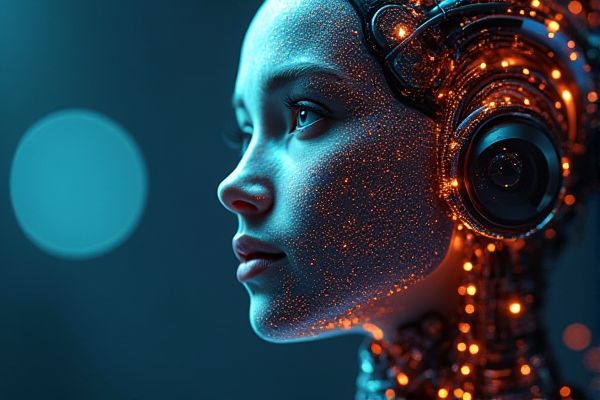
AI is transforming the art world by enabling innovative expressions and techniques that were previously unimaginable. Artists harness machine learning algorithms to create unique pieces, generating visuals that blend human creativity with computational power. Tools like GANs (Generative Adversarial Networks) allow for the creation of entirely new images, styles, and even music, expanding the boundaries of artistic mediums. This technology not only fosters collaboration between artists and machines but also opens discussions about authorship, originality, and the future of creativity.
AI usage in art
Generative Art Algorithms
Generative art algorithms utilize AI to create unique artworks, enabling artists to explore new creative possibilities. These algorithms analyze vast datasets to generate patterns and images that may not be achievable by traditional methods. Institutions like the MIT Media Lab are at the forefront of this technology, showcasing its potential in art and design. The chance for artists to collaborate with AI opens avenues for innovative expressions and expanded artistic boundaries.
Style Transfer Technology
AI usage in art, particularly through Style Transfer technology, offers the possibility of transforming images by applying the artistic styles of famous painters, such as Vincent van Gogh. This technique enables artists and designers to explore new creative avenues, potentially enhancing their portfolios with unique visual aesthetics. The chance for commercial applications expands as businesses, like design agencies, adopt these technologies for branding and advertising purposes. As the accessibility of AI tools increases, more artists may gain the opportunity to experiment with and innovate within their craft.
Interactive Installations
AI usage in art can enhance interactive installations by creating dynamic experiences that respond to viewer engagement. Such installations can analyze user input in real-time, allowing for personalized artistic expressions that evolve with audience interaction. For instance, museums like the San Francisco Museum of Modern Art have showcased AI-generated artworks that adapt to visitor movements and preferences. This potential for customization may lead to a unique form of art appreciation and deeper connections between the audience and the artwork.
AI as Creative Collaborator
AI can serve as a creative collaborator in art, offering artists new tools and techniques to enhance their work. For example, artists using platforms like DeepArt can experiment with styles and generate unique compositions. This collaboration can lead to innovative artwork that might not have been possible through traditional methods alone. The potential for discovery and exploration in artistic expression increases as AI technology continues to evolve.
Automated Art Curation
AI usage in art, specifically in automated art curation, presents a significant opportunity for galleries and museums to enhance their collections. By leveraging algorithms, institutions like the Museum of Modern Art can analyze viewer preferences and curate exhibitions tailored to audience interests. This technology offers the chance to discover new artists and trends within the art community, optimizing exposure for emerging talents. Furthermore, automated curation minimizes the time spent on manual selection processes, enabling a more dynamic and responsive approach to art presentation.
Data-Driven Aesthetic Analysis
AI can enhance creativity in art through data-driven aesthetic analysis. By analyzing patterns and trends in artworks, AI can identify qualities that resonate with audiences, improving artists' chances of success. For instance, institutions like the Museum of Modern Art might utilize these insights to curate more appealing exhibitions. This approach opens up new avenues for artistic expression while potentially increasing engagement and appreciation from viewers.
Virtual Reality Art Creations
AI can enhance the creative process in virtual reality art by generating unique spatial designs based on user input. This technology allows artists to explore new dimensions, creating immersive experiences that are more interactive. For example, institutions like the School of Visual Arts are incorporating AI tools to help students expand their artistic vision. This combination of AI and VR offers artists the possibility of discovering innovative forms and styles that were previously unattainable.
Emotion Recognition in Art
AI can analyze artistic styles and patterns to generate new artworks, potentially enhancing creativity. Emotion recognition technology can evaluate viewers' reactions to art, providing insights into emotional engagement. Institutions like museums might leverage these advancements to tailor exhibits that resonate more deeply with audiences. The integration of AI in art could open up possibilities for new forms of interactive experiences.
Art Restoration and Reconstruction
AI offers the potential to enhance art restoration and reconstruction by analyzing damaged artworks and suggesting precise repair techniques. For instance, institutions like the Louvre have begun exploring AI to recreate missing segments of paintings based on existing patterns. This technology can seamlessly integrate historical context, allowing for more accurate restorations. The chance to preserve cultural heritage through AI-driven methods presents a significant advantage for future generations.
Personalized Artistic Experiences
AI usage in art can enhance personalized artistic experiences by analyzing individual preferences and styles. For example, platforms like Artfinder utilize algorithms to recommend artwork based on a user's previous interactions. This tailored approach allows users to discover pieces that resonate with their tastes more effectively. The potential for AI to create custom art pieces based on user input further illustrates its advantages in the creative sector.
 techknowy.com
techknowy.com